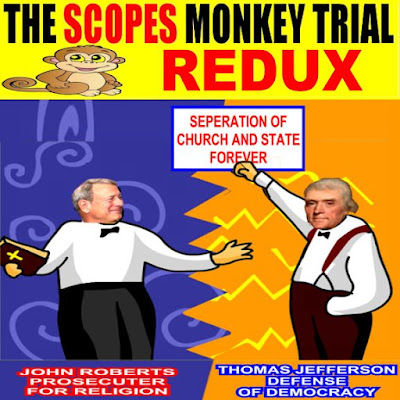REDUX: SEPARATION OF CHURCH AND STATE
SCOPES MONKEY TRIAL AT THE SUPREME COURT
The separation of church and state—a concept so enshrined in American constitutional lore that it almost feels like a fairy tale. You know, the kind where the Founding Fathers are the wise old wizards casting spells to protect the land from the dark forces of religious tyranny. But alas, in our modern era, it seems some folks are more interested in playing the role of the mischievous trickster, attempting to blur those sacred lines with a wink and a nod that screams, "Who needs separation when you have divine intervention?"
Let's start with the basics. The Founding Fathers—those powdered-wig aficionados—were quite clear about their intentions. Thomas Jefferson and James Madison were practically shouting from their quill-penned soapboxes that government and religion should remain as separate as oil and water. They feared that mixing the two would create a cocktail of persecution and conflict, not to mention a hangover for democracy itself. Jefferson even coined the phrase "wall of separation between church and state," which, for the record, is not an architectural suggestion but rather a metaphorical boundary meant to keep religious influence out of government affairs.
Fast forward to today, where the Supreme Court seems to be playing a game of Jenga with that very wall. The conservative majority is busy pulling out blocks one by one, arguing that excluding religious schools from public funding is discriminatory. Because, clearly, taxpayer dollars should be used to fund institutions that teach Catholic doctrine. I mean, who wouldn't want their hard-earned money going toward indoctrinating children in a faith they may not even subscribe to? It's like funding a fairy tale theme park where only Cinderella gets a castle.
The case of Oklahoma Statewide Charter School Board v. Drummond is a prime example. Conservative activists are pushing to expand state funding for religious education, and the Supreme Court's conservative justices seem inclined to agree. Justice Brett Kavanaugh even argues that excluding religious schools from funding is discriminatory, dismissing concerns about non-Catholic taxpayers subsidizing Catholic indoctrination. Because why should we worry about little things like religious liberty when we can just bulldoze right through them?
It's almost as if the Supreme Court is channeling its inner William Jennings Bryan from the Scopes Monkey Trial—another historical gem where science and religion clashed like titans in a courtroom carnival. Bryan famously defended anti-evolution laws with fervor that could rival any modern-day creationist. The trial exposed tensions between science and religion, highlighting how one man's myth is another man's religion. So why not teach fairy tales as fact? After all, if we can fund religious schools with taxpayer money, surely we can offer courses on unicorn husbandry.
And speaking of education, let's not forget the ongoing saga of teaching creationism in public schools. Despite legal setbacks like Edwards v. Aguillard, which deemed teaching creationism as truth unconstitutional, efforts to sneak religious views into curricula persist. Enter "stealth creationism," a strategy so subtle it might as well be wearing an invisibility cloak. These legislative efforts use the guise of "academic freedom" to critique evolution without directly invoking religion. It's like trying to pass off dragons as endangered species—creative, but ultimately misleading.
But wait, there's more! The Tennessee Senate recently passed a bill prohibiting K-8 teachers from discussing homosexuality—a move reminiscent of past controversies like the Scopes Monkey Trial. Critics argue the bill seeks to eliminate discussion rather than provide reasonable controls, potentially leaving bullied children without support. Because who needs educated discourse when silence is golden? Let's just pretend issues don't exist and hope they magically resolve themselves.
In this theater of absurdity, Chief Justice John Roberts plays a starring role. Over two decades, he has authored key rulings that favor religious entities in receiving state benefits. Playground resurfacing funds? Check. Tuition assistance for religious schools? Double check. Now, he's faced with a case involving direct funding for a Catholic charter school in Oklahoma, raising First Amendment concerns. Roberts' vote is crucial, as the court appears divided, and his decision could affirm or challenge the trend of increased state involvement with religious institutions.
And so we find ourselves at a crossroads where the Supreme Court appears ready to allow religious schools to receive state funding as charter schools—a decision that could challenge existing laws requiring charter schools to be non-sectarian. Conservative justices argue that excluding religious schools from funding is discriminatory, while liberals warn of potential widespread implications. It's like watching a game of chess where one side plays by the rules and the other flips the board when things don't go their way.
In conclusion, the separation of church and state is more than just settled law; it's a principle that protects religious freedom and ensures government serves all citizens equally. Yet here we are, witnessing attempts to dismantle this foundation brick by brick under the guise of combating discrimination. Perhaps it's time to remind ourselves that one person's religion should not dictate another's reality—unless we're all willing to fund fairy tale theme parks with taxpayer dollars. Until then, let's keep our magic wands at bay and focus on preserving the wall that Jefferson so wisely envisioned.
The Great American Church and State Tug-of-War
https://open.substack.com/pub/ru4people/p/the-great-american-church-and-state?r=kja7f&utm_campaign=post&utm_medium=web&showWelcomeOnShare=false



